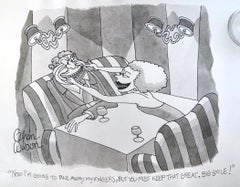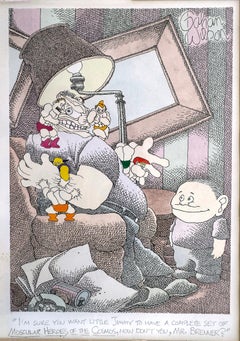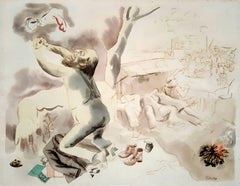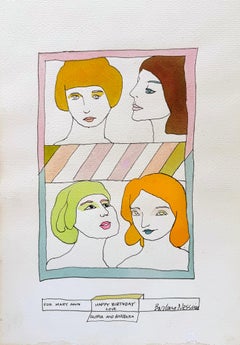Want more images or videos?
Request additional images or videos from the seller
1 of 8
Ludwig Bemelmans, 1898-1962Debonair Man Cuts his Mustache in Front of Mirror1950s
1950s
$18,000List Price
About the Item
- Creator:Ludwig Bemelmans, 1898-1962 (1898 - 1962, American)
- Creation Year:1950s
- Dimensions:Height: 11.75 in (29.85 cm)Width: 8.85 in (22.48 cm)
- Medium:
- Movement & Style:
- Period:
- Condition:Some fading of the watercolor color in the mirror reflections. Buckling to the paper most noticeably with raking light, the edges of the sheet are unevenly cut, possibly inherent with the work. Sheet adhered to support paper.
- Gallery Location:Miami, FL
- Reference Number:1stDibs: LU385310098852
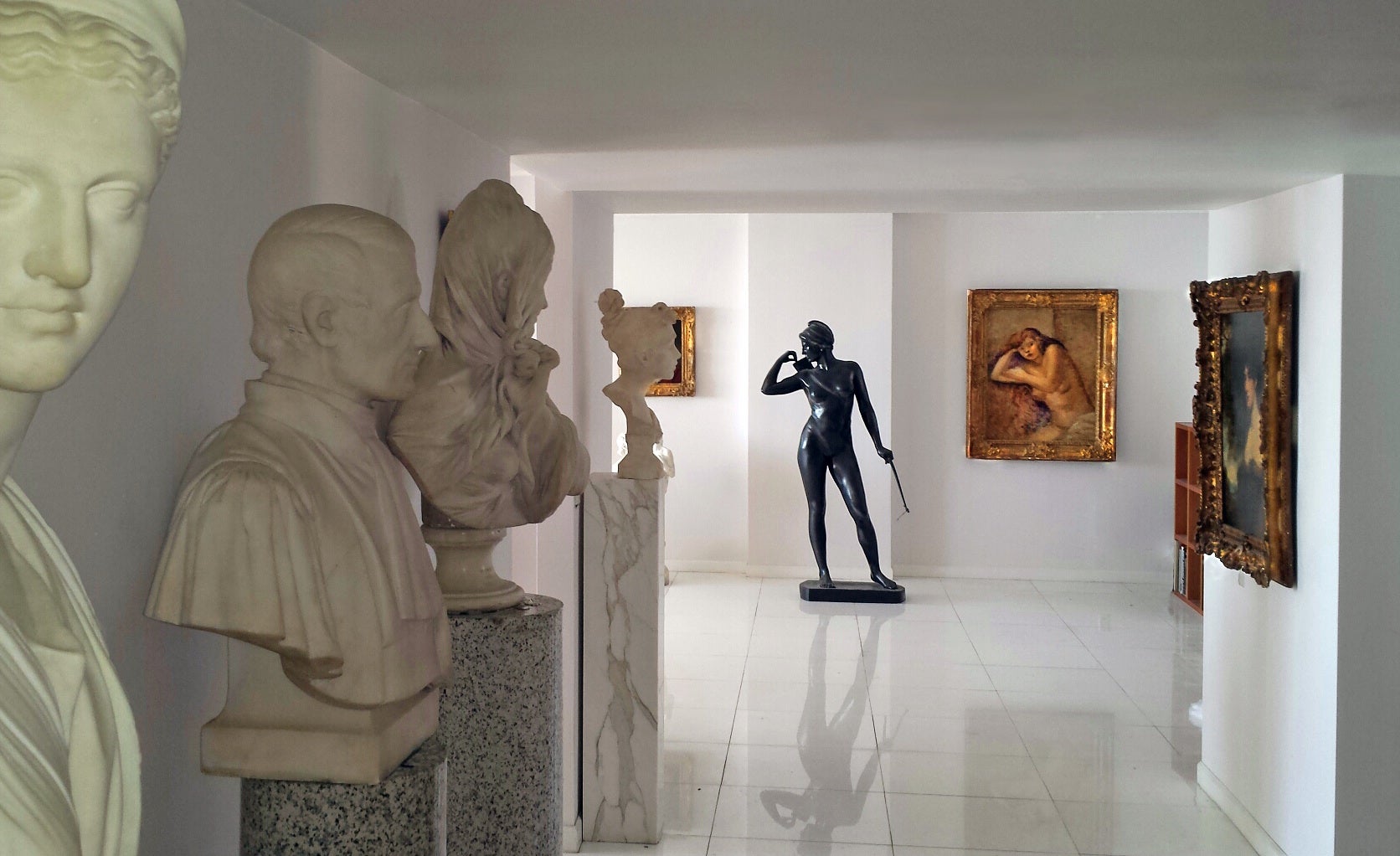
About the Seller
5.0
Vetted Professional Seller
Every seller passes strict standards for authenticity and reliability
Established in 2005
1stDibs seller since 2016
117 sales on 1stDibs
Typical response time: 1 hour
Authenticity Guarantee
In the unlikely event there’s an issue with an item’s authenticity, contact us within 1 year for a full refund. DetailsMoney-Back Guarantee
If your item is not as described, is damaged in transit, or does not arrive, contact us within 7 days for a full refund. Details24-Hour Cancellation
You have a 24-hour grace period in which to reconsider your purchase, with no questions asked.Vetted Professional Sellers
Our world-class sellers must adhere to strict standards for service and quality, maintaining the integrity of our listings.Price-Match Guarantee
If you find that a seller listed the same item for a lower price elsewhere, we’ll match it.Trusted Global Delivery
Our best-in-class carrier network provides specialized shipping options worldwide, including custom delivery.You May Also Like
Polymorphisms II - Haude Bernabé, 21st Century, Contemporary Figurative Drawing
By Haude Bernabé
Located in Paris, FR
Ink and graphite on paper
Signed, entitled and dated below
Category
2010s Outsider Art Figurative Drawings and Watercolors
Materials
Paper, Ink, Graphite
$3,438
H 29.93 in W 22.05 in
Polymorphisms IV - Haude Bernabé, 21st Century, Contemporary figurative drawing
By Haude Bernabé
Located in Paris, FR
Ink and graphite on paper
Signed, dated and entitled lower left
Category
2010s Outsider Art Figurative Drawings and Watercolors
Materials
Paper, Ink, Graphite
$3,438
H 29.93 in W 22.05 in
Metamorphosis III - Haude Bernabé, 21st Century, Contemporary Figurative Drawing
By Haude Bernabé
Located in Paris, FR
Ink and graphite on paper
Signed, entitled and dated below
Category
2010s Outsider Art Figurative Drawings and Watercolors
Materials
Paper, Ink, Graphite
$3,438
H 25.2 in W 19.69 in
Metamorphosis I - Haude Bernabé, 21st Century, Contemporary Figurative Drawing
By Haude Bernabé
Located in Paris, FR
Ink and graphite on paper
Signed, entitled and dated below
Category
2010s Outsider Art Figurative Drawings and Watercolors
Materials
Paper, Ink, Graphite
$3,438
H 25.2 in W 19.69 in
Strangers - Haude Bernabé, 21st Century, Contemporary Figurative Drawing
By Haude Bernabé
Located in Paris, FR
Ink and graphite on paper
Signed, entitled and dated lower right by the artist
Category
2010s Outsider Art Figurative Drawings and Watercolors
Materials
Paper, Ink, Graphite
$4,150
H 22.05 in W 29.53 in D 1.97 in
The children of fire Haude Bernabé 21st Century Contemporary Figurative Drawing
By Haude Bernabé
Located in Paris, FR
Ink and graphite on paper
Signed, entitled and dated lower left by the artist
Category
2010s Outsider Art Figurative Drawings and Watercolors
Materials
Paper, Ink, Graphite
$4,150
H 22.05 in W 29.53 in D 1.97 in
Come back Julien Wolf Contemporary art drawing expressionnist outsider colour
By Julien Wolf
Located in Paris, FR
Pastel on paper pasted on canvas
Hand-signed on the back by the artist
“At first glance, we are invited to a colorful carnival. Everything is movement here! As if Julien Wolf had tr...
Category
2010s Outsider Art Figurative Drawings and Watercolors
Materials
Canvas, Paper, Pastel
$5,810
H 55.12 in W 39.38 in D 1.97 in
Tattoed character Geneviève Seillé Contemporary art outsider art drawing colour
By Geneviève Seillé
Located in Paris, FR
Mixed media drawing on paper
Dated and signed on the back
In the plastic work of Geneviève Seillé, the word, like a sign, reigns supreme. An object o...
Category
2010s Outsider Art Figurative Drawings and Watercolors
Materials
Paper, Color Pencil, Graphite
$4,505
H 40.56 in W 28.75 in
Broken paper towel Julien Wolf Contemporary art drawing expressionnist outsider
By Julien Wolf
Located in Paris, FR
Pastel on paper pasted on canvas
Hand-signed on the back by the artist
“At first glance, we are invited to a colorful carnival. Everything is movement here! As if Julien Wolf had tr...
Category
2010s Outsider Art Figurative Drawings and Watercolors
Materials
Canvas, Paper, Pastel
$5,810
H 55.12 in W 39.38 in D 1.97 in
Tattoed character Geneviève Seillé Contemporary art outsider art drawing colour
By Geneviève Seillé
Located in Paris, FR
Mixed media drawing on paper
Dated and signed on the back
In the plastic work of Geneviève Seillé, the word, like a sign, reigns supreme. An object o...
Category
2010s Outsider Art Figurative Drawings and Watercolors
Materials
Paper, Color Pencil, Graphite
$4,505
H 46.07 in W 29.14 in
More From This Seller
View AllMan with Big Smile - New Yorker Cartoon
Located in Miami, FL
If a smile is an expression of momentary happiness, then the female in this cartoon appears driven to turn a moment into a more extended period of time. Leave it to Gahan Wilson to ...
Category
Early 2000s Outsider Art Portrait Drawings and Watercolors
Materials
Paper, Ink, Watercolor, Pen
Macabre Cartoon Children's Toys Attack Father - Playboy Cartoon
Located in Miami, FL
A child looks on with glee as his "Muscular Heroes of the Cosmos" Toys transform from inanimate objects to real, actionable beings and beat up his father. Signed upper right, Gahan...
Category
1980s Outsider Art Figurative Drawings and Watercolors
Materials
Paper, Ink, Watercolor
Christus am Oelberg - Christ on the Mount of Olives
By George Grosz
Located in Miami, FL
This work is accompanied by a Photo-certificate and essay from Ralph Jentsch who will include it in his forthcoming catalogue raisonné
Signed lower right.
Estate stamp on verso....
Category
1930s Dada Figurative Drawings and Watercolors
Materials
Ink, Watercolor
Happy Birthday Drawing: Love Barbara Nessim and Gloria Steinem
By Barbara Nessim
Located in Miami, FL
In the late 1960s, Barbara Nessim and Gloria Steinem were roommates. This stylised and colorful illustration appears to be a highly personalized birthday card to their friend Mary A...
Category
1960s American Modern Portrait Drawings and Watercolors
Materials
Ink, Watercolor, Archival Paper
House Arrest - Conceptual Art for The New Yorker
Located in Miami, FL
Conceptual Artist Gahan Wilson is also a cartoonist. He is a master at telling a story in one picture. Thirdly, he delights the viewer's eyes with his instantly recognizable drawing ...
Category
1990s Surrealist Figurative Drawings and Watercolors
Materials
Paper, Ink, Watercolor, Pen
Vogue Magazine Illustration
Located in Miami, FL
"Mademoiselle X" story illustration
for Vogue February 1, 1934, watercolor and ink, reverse signed in pencil "Benito for Madame X," pencil inscription "Feb.1, 1934 / Page 51 / 316," ...
Category
1930s Art Deco Figurative Drawings and Watercolors
Materials
Paper, Ink, Watercolor
Recently Viewed
View AllMore Ways To Browse
Ink And Watercolor Woman
Vintage Ballpoint Pens
Mid Century Sketch Pencil
Antique Chalk Art
Kurt Cobain
Paris Alexander
Charcoal Figure Drawing
Cubist Drawings
Pen And Ink Drawings Female
Contemporary Chinese Ink Paintings
Charcoal Drawings Of A Dancer
Lgbtq Art
Alexander Warren Montel Lanvin
Vintage 1950S Nudes
Original Vintage Illustration Art
Antique Pen And Ink Drawings
Couples Drawings
Male Figure Painting
